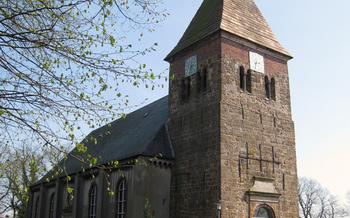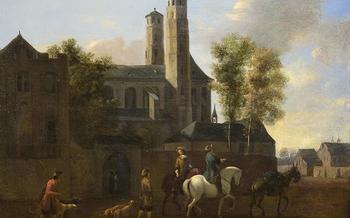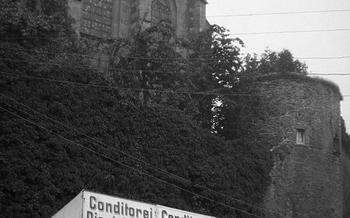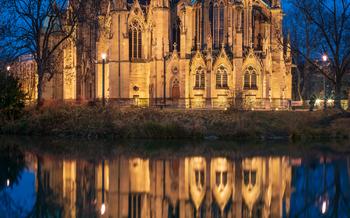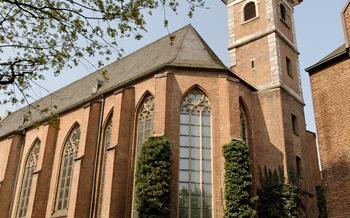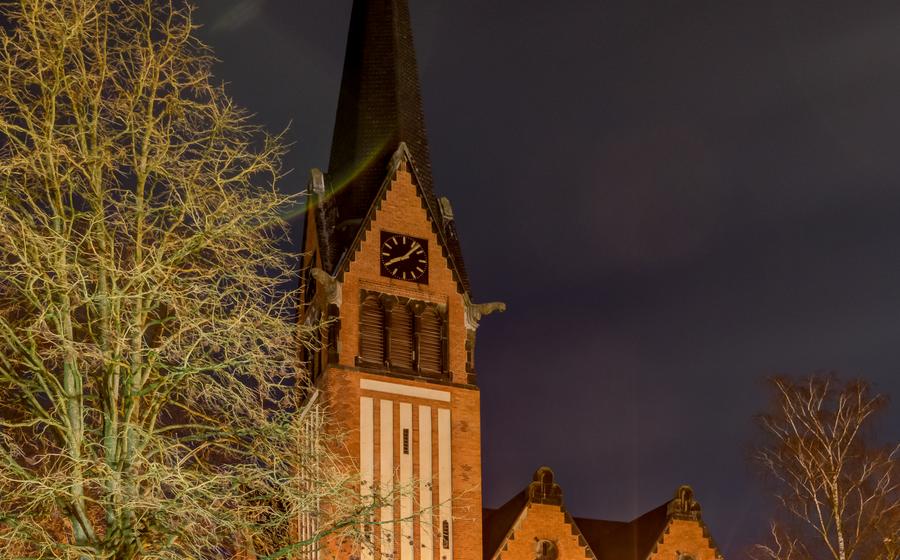
Church of the Redeemer
- Church of the Redeemer: A Symbol of Renewal
- A Place of Worship and Remembrance
- Exploring the Church's Interior
- Engaging with the Local Community
- A Center for Music and the Arts
- The Crypt: A Hidden Gem
- The Church Tower: A Panoramic View
- Guided Tours: Unveiling the Secrets
- Accessibility for All
- The Church Square: A Lively Gathering Place
- Practical Tips and Recommendations
- A Vibrant Square
- A Vibrant Square, a Lively Community
Church of the Redeemer: A Symbol of Renewal
The Church of the Redeemer stands as a testament to Münster's ability to rise from the ashes of war and embrace a new era of hope and renewal. Constructed in the years following World War II, the church reflects the city's determination to rebuild and create a brighter future. Its modern design, characterized by clean lines, geometric shapes, and an abundance of natural light, symbolizes a departure from the traditional Gothic style that dominated German architecture for centuries. The church's unique features, such as its suspended ceiling and the cross that dominates the nave, serve as powerful reminders of the suffering and resilience of the Münster community during the war. The Church of the Redeemer is not just a place of worship but also a symbol of the city's unwavering spirit and its commitment to peace and reconciliation.
A Place of Worship and Remembrance
The Church of the Redeemer serves as a spiritual center for the local community, providing a place for worship, reflection, and remembrance. Its history as a post-war reconstruction adds to its profound significance, as it stands as a symbol of renewal and hope. The church plays a crucial role in commemorating the victims of war and honoring their memory. The cross, a prominent feature of the church's design, serves as a reminder of the suffering and sacrifice endured during wartime. The nave, with its spacious interior, fosters a sense of unity and community among those who gather within its walls.
Exploring the Church's Interior
Stepping inside the Church of the Redeemer, visitors are greeted by a spacious and light-filled sanctuary. The church's modern design emphasizes simplicity and functionality, creating a serene and welcoming atmosphere. The nave, the main body of the church, stretches towards the altar, drawing the eye to the focal point of the worship space.
The church's interior is adorned with impressive stained-glass windows, which bathe the sanctuary in colorful light. The windows depict biblical scenes and figures, adding a touch of artistic beauty and spiritual inspiration to the space. The altar, pulpit, and baptismal font are made of natural materials, such as wood and stone, reflecting the church's commitment to sustainability and harmony with nature.
The altar, a central element of the church, is a symbol of communion and remembrance. It is where the Eucharist, or Holy Communion, is celebrated, and where the community gathers to share in the bread and wine that represent the body and blood of Christ. The pulpit, from which the minister delivers sermons and readings, is positioned to the side of the altar, emphasizing the importance of the spoken word in the church's worship and teaching.
The baptismal font, located near the entrance of the church, symbolizes the sacrament of baptism, through which individuals are welcomed into the Christian faith. The font is often made of stone or marble, representing the solidity and permanence of the covenant between God and the believer.
Engaging with the Local Community
Beyond its spiritual significance, the Church of the Redeemer also serves as a vibrant community hub. Attend a religious service to immerse yourself in the local faith and witness the church's role as a spiritual center. Engage with the friendly locals, who are always willing to share stories and insights about their beloved church. Participate in community events, such as concerts, exhibitions, or charity gatherings, to connect with the vibrant and welcoming community. These events offer a unique opportunity to experience the church's commitment to fostering social cohesion and supporting local initiatives.
A Center for Music and the Arts
The Church of the Redeemer is not only a place of worship but also a vibrant center for music and the arts. Throughout the year, the church hosts a variety of concerts, exhibitions, and performances, showcasing both local talent and renowned international artists. From classical music recitals to contemporary art installations, there is something for everyone to enjoy.
The church's spacious sanctuary and excellent acoustics make it an ideal venue for musical performances. The church choir regularly performs during services and special concerts, filling the space with beautiful harmonies. The church also hosts guest musicians and ensembles, offering a platform for talented artists to share their work with the community.
In addition to music, the church also hosts art exhibitions and other cultural events. The crypt, with its unique atmosphere, has been used for art installations and performances, creating an immersive and intimate experience for visitors. The church also collaborates with local arts organizations to bring a diverse range of exhibitions and events to the community.
By promoting local talent and international artists, the Church of the Redeemer plays a vital role in fostering a vibrant cultural scene in Münster. It is a place where people can come together to appreciate and celebrate the arts, enriching the cultural landscape of the city.
The Crypt: A Hidden Gem
Beneath the Church of the Redeemer lies a hidden treasure - the crypt. This underground chamber, accessible through a discreet entrance, offers a glimpse into the church's past and the fascinating history of Münster.
Archaeological excavations in the crypt have unearthed a wealth of artifacts, including ancient pottery, coins, and human remains. These discoveries provide valuable insights into the lives of Münster's inhabitants throughout the centuries.
The crypt also houses a small museum, showcasing these historical finds and explaining their significance. Visitors can learn about the church's construction, its role in the community, and the events that have shaped its history.
Exploring the crypt is like embarking on a journey through time. It's a chance to connect with the past, understand the present, and appreciate the enduring legacy of the Church of the Redeemer.
The Church Tower: A Panoramic View
Ascend the Church of the Redeemer's majestic tower for a breathtaking panorama of Münster. The climb may be strenuous, but the reward is an unparalleled vista. From this lofty vantage point, the city unfurls before your eyes, a tapestry of architectural wonders, verdant parks, and meandering waterways. Gaze upon the terracotta roofs of historic buildings, the spires of neighboring churches piercing the heavens, and the distant hills providing a serene backdrop. On a clear day, the Teutoburg Forest, with its undulating hills and dense woodlands, can be glimpsed on the horizon. This panoramic experience offers a unique perspective, allowing you to appreciate Münster's rich history and vibrant modernity.
Guided Tours: Unveiling the Secrets
To truly delve into the rich history and architectural significance of the Church of the Redeemer, booking a guided tour is highly recommended. Knowledgeable guides will lead you through the church, shedding light on its fascinating past, unique design elements, and symbolic features. They will provide insightful commentary on the church's role in Münster's post-war reconstruction and its importance as a spiritual and cultural landmark.
Guided tours are available in various languages and can be tailored to specific interests, whether you're an architecture enthusiast, a history buff, or simply curious about the church's connection to the local community. By joining a guided tour, you'll gain a deeper understanding and appreciation for this remarkable building and its place in Münster's cultural landscape.
Accessibility for All
The Church of the Redeemer is committed to ensuring that all visitors have an inclusive and accessible experience. Wheelchair ramps and elevators provide easy access to all levels of the church, including the sanctuary, crypt, and tower. Designated parking spaces for visitors with disabilities are available nearby. Additionally, the church offers assistive listening devices and Braille hymnals for those with hearing or visual impairments. By providing these amenities, the Church of the Redeemer strives to create a welcoming and accessible environment for all.
The Church Square: A Lively Gathering Place
The Church of the Redeemer stands at the heart of a vibrant and picturesque square, inviting visitors to explore its surroundings. The square is a popular gathering place for locals and tourists alike, offering a blend of history, culture, and lively ambiance. Take a leisurely stroll through the square and admire the beautifully preserved historical buildings that line its cobblestone streets.
Enjoy a cup of coffee or a delightful meal at one of the charming cafes or restaurants that dot the square, soaking in the vibrant atmosphere. On warm summer days, the square transforms into a bustling outdoor gathering spot, with people enjoying picnics, street performances, and the lively chatter that fills the air.
Practical Tips and Recommendations
- Plan Your Visit: Check the church's website for service times, events, and exhibitions. Consider visiting during the summer months for longer daylight hours and warmer weather.
- Guided Tours: Book a guided tour in advance to gain a deeper understanding of the church's history, architecture, and symbolism. Tours are available in various languages.
- Accessibility: The church is wheelchair accessible and offers facilities for visitors with disabilities. Contact the church office for assistance if needed.
- Photography: Photography is allowed inside the church for personal use. However, flash photography and tripods are not permitted.
- Respectful Behavior: Remember that the Church of the Redeemer is an active place of worship. Be respectful of the religious services and maintain a quiet and solemn demeanor while inside the church.
A Vibrant Square
The church square, officially known as Erbdrostenhof, is a bustling hub of activity, where locals and visitors alike gather to soak in the lively atmosphere. Surrounded by charming historical buildings, the square is a feast for the eyes, with its intricate facades and colorful storefronts. Straßencafés and restaurants spill out onto the cobblestones, inviting passersby to linger and savor the moment. The square is also a popular venue for markets, festivals, and other events throughout the year, adding to its vibrant and welcoming spirit.
A Vibrant Square, a Lively Community
The Church Square, where the Church of the Redeemer stands, is not just a physical space but a hub of social interactions and community life. Locals and visitors alike gather here to soak in the lively atmosphere, whether it's a sunny afternoon or a balmy summer evening. Outdoor cafes and restaurants line the square, inviting passersby to linger over a cup of coffee, indulge in delicious pastries, or savor a hearty meal. The square transforms into a vibrant gathering place, where friends and families come together to exchange stories, share laughter, and celebrate life. Whether you're a history buff, an architecture enthusiast, a spiritual seeker, or simply someone who appreciates the charm of a lively public space, the Church of the Redeemer and its surrounding square offer a unique and memorable experience.

